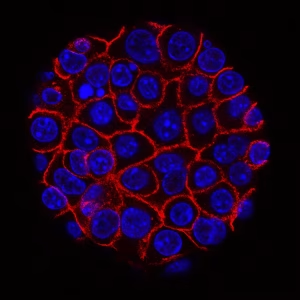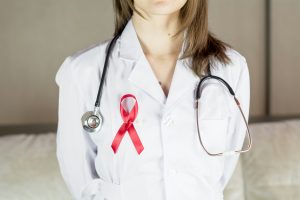Breast cancer
Breast cancer is a common cancer among women across the globe, but it can also be developed among men; however, this is rarer. It is essential to be familiar with how to detect the symptoms of breast cancer—diagnosing it at an early stage generally means that treatment will be more effective and successful.
Depending on the type, stage, and location of breast cancer in the breast, its symptoms will vary. Although many symptoms are clear-cut, others may be more subtle or mistaken for less serious conditions. Understanding the early warning signs can make it much easier for your doctor to find a successful treatment method and allow you to heal.

What are the symptoms of breast cancer?
A lump in the breast is one of the most prevalent and well-known signs of breast cancer. The lump might be firm, irregular in form, and painless (but some lumps could be tender or painful). In early breast cancer, a lump is often the initial sign of the disease.
It is worth noting, though, that breast lumps aren’t always cancerous; indeed, most are benign (non-cancerous) — cysts or fibrocystic changes tend to be quite common. However, a healthcare provider should evaluate any new or unusual lump to exclude cancer.
Another common symptom is a change in size, shape, or appearance of the breast (besides lumps). These can be detected on self-examine or may also be noticeable in others.
You might notice one breast gaining size (or swelling) over time than the other, or that your skin looks dimpled or puckered like orange peel. This is called peau d’orange, and it may be a sign that the cancer has spread to the skin, disturbing lymphatic drainage of breast tissue.
And those symptoms are reddened, irritated, and/or itchy skin on the breast; that would be another indication of breast cancer. They can be mild initially, but do not ignore them if they last long. Other times they may look more like thickening of the skin or be warm and swelling, which could signal cancer infection or inflammation.
These include swelling and redness, as well as the characteristic signs of inflammatory breast cancer, a rare but aggressive form of the disease that needs urgent medical treatment.
Nipple Changes
Breast cancer also commonly manifests through changes to the nipple. This can involve inversion or retraction of the nipple, where the nipple looks as though it is being pulled in instead of pushing out. Others might also see some nipple discharge (clear, bloody, or purulent).
Any nipple discharge that happens without squeezing the nipple—or spontaneous discharge, as it is called—always warrants further investigation because this type of discharge can indicate cancer, especially if it originates in one breast only.
Occasionally, the skin area surrounding the nipple (areola) could be scaly or flaky and red, which frequently signifies a type of breast ailment called Paget’s approach to breast. Paget’s disease of the nipple This uncommon, specific type of breast cancer commonly influences the area region around a woman’s breast and areola, sometimes along with itching, burning, or tenderness.
Paget’s disease can be mistaken for eczema or other benign skin conditions and early symptoms could easily be confused with those of other benign skin conditions so it is necessary to consider Paget’s disease when making a differential diagnosis.
Pain or Tenderness
Breast cancer does not often present with early symptoms of breast pain but can sometimes cause it as the tumor grows or metastasizes. Breast cancer may cause some people with this disease to feel discomfort or pain; this can be a constant ache, stabbing pain, or sensation of fullness in the breast.
But the majority of breast cancer pain does not ebb and flow like cycles associated with menses or hormonal patterns. Although breast pain is typically related to benign etiologies, such as cyclic hormonal changes or fibrocystic breast condition, new onset, localized, or culture of unexplained breast pain should be evaluated by your healthcare provider.
Swelling or lumps under the armpit
Lumps or swelling in your armpit (axillary lymph nodes) — also a sign of breast cancer The lymph nodes are component of the immune system that are dispersed around the body, like in underarm area. When the cancer spirals from the breast to the lymph nodes, they can become swollen, hard vessels, or sensitive.
In some cases, the swelling of axillary lymph nodes can be the first manifestation of breast cancer, especially when a cancerous tumor can’t be felt in the breast tissue yet.
Note that swollen lymph nodes in the armpit do not necessarily mean cancer, as infections or other conditions can also cause it. Yet, if they happen in the same context as other breast changes, that should be evaluated further.
Advanced Symptoms
As breast cancer progresses, more serious symptoms may occur. These symptoms typically suggest that the cancer has metastasized from just the breast to other areas of the body. When breast cancer is more advanced, it can be spread to other parts of the body, which could potentially cause pain somewhere besides the breast, specifically bone, liver, or lung.
When cancer has metastasized to the bones, it can lead to localized back pain, pelvic pain, or other regions of the body. Spread to the liver can cause jaundice (yellowing of the skin or eyes) or swelling in your abdomen.
When it spreads to the lungs, metastatic breast cancer can lead to symptoms such as a persistent cough, feeling short of breath, or having chest pain. These more advanced symptoms are rare in early-stage breast cancers, but they emphasize the need for routine screenings, early detection, and treatment.
Breast Cancer Symptoms that Are Unique to Inflammatory
Inflammatory breast cancer (IBC) is one of the rarest yet most aggressive types of breast cancer, and it acts differently from more common forms of breast cancer. Instead of creating a separate lump, IBC inflames the breast and makes it red and warm.
The breast may feel hard or heavy, and the skin over it can look dimpled or pitted. These symptoms often present rapidly and can be noticed at their worst within weeks of infection.
Because the symptoms of inflammatory breast cancer (IBC) can sometimes be confused for an infection, some women may interpret those symptoms as mastitis—an inflammation of breast tissue that occurs in breastfeeding women. Though it resembles mastitis, IBC doesn’t respond to antibiotics, and symptoms usually get worse with time. IBC is known to be more aggressive than other breast cancer types, so early diagnosis and quick treatment are essential.
Systemic Symptoms
Sometimes breast cancer may have systemic symptoms, which are general signs of illness throughout the body. These will consist of weight loss for no apparent reason, tiredness, high temperature, and also a general feeling of being unwell.
Though these signs are more often connected to breast cancer well-developed or metastatic, they might eventuate even earlier in the illness program. Seek medical attention when these symptoms, along with other signs of breast cancer, occur.
Why identifying this situation early is crucial!
It is of great importance to recognize the accompanying symptoms of breast cancer early on. Whether it is a few of the above or all others on this list are rather clear cut, some of these signs and symptoms may be slight and dismissed for less serious conditions.
Breast self-exams and routine mammograms may help find breast cancer early, when it is easier to treat. Specifically, mammography is crucial for women older than 40 years or even earlier if the patient has a family history of breast cancer or other risk factors.
Not all breast changes mean cancer, and it is worth keeping that in mind. Conditions like fibrocystic breast changes, cysts, or hormone surges may have symptoms mimicking those of the cancer. Any other new, unexplained change in the breast should be evaluated by a health care professional to determine whether cancer is present or could develop.
Other imaging tests, including ultrasound or MRI, may also be ordered by a doctor in addition to a biopsy, which is needed to determine if a lump is cancerous.





Leave a Reply